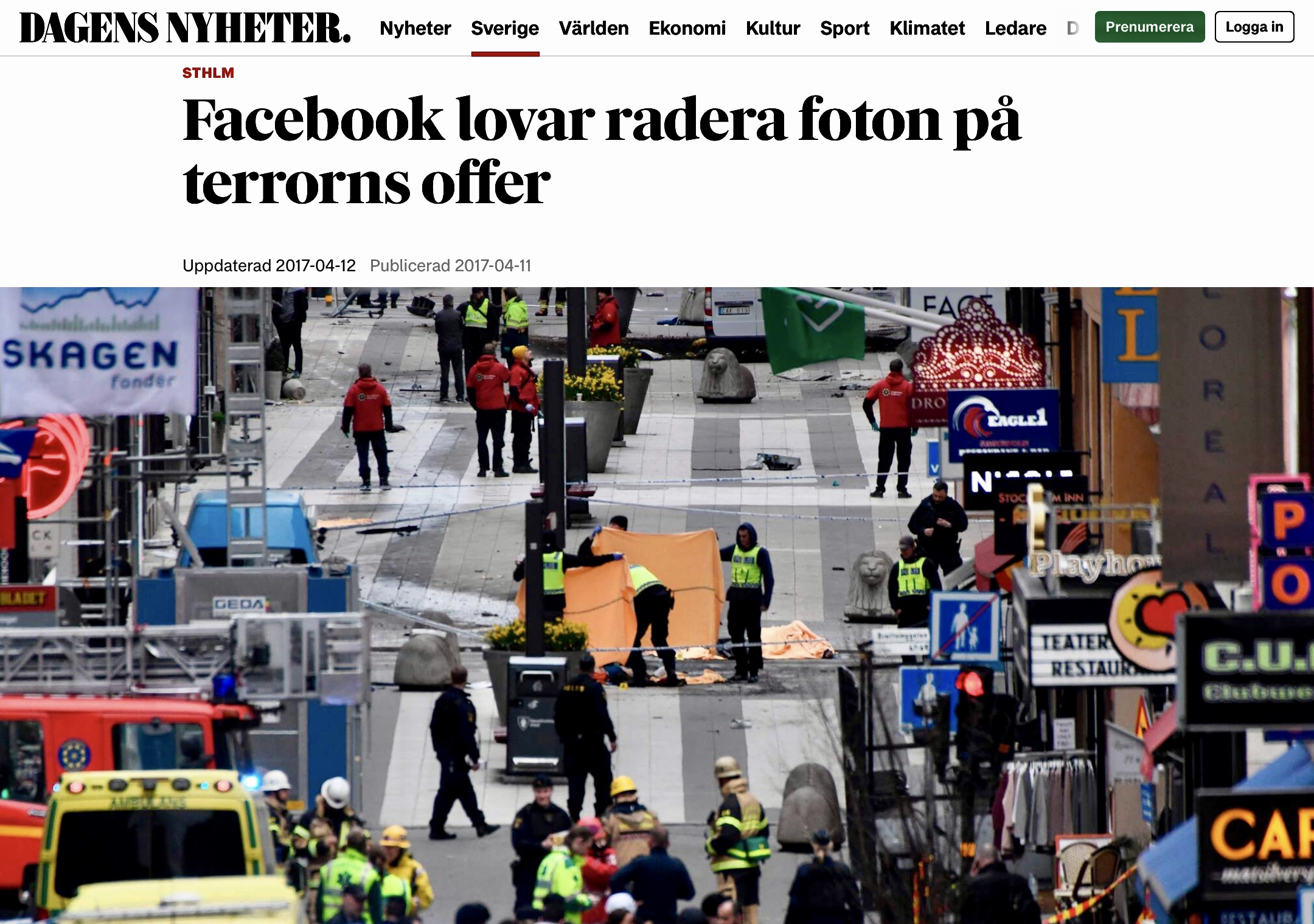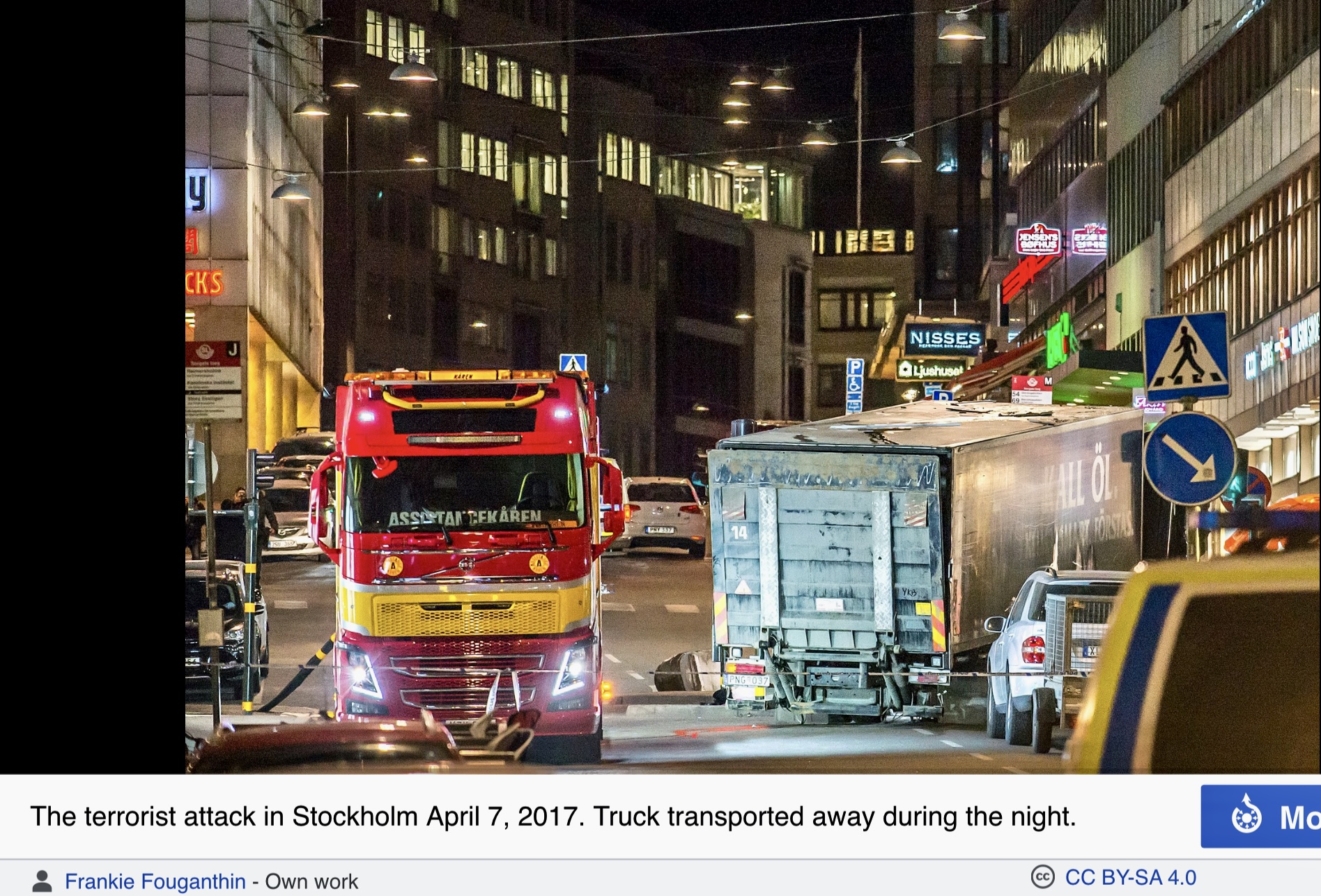Last edited: 29 November 2023
Hazard:
TerrorYear:
2017Location:
Stockholm, SwedenScale:
CityPublishing Organisation
unknown
Category
Real-world
Theme
Crowdsourcing, Social Media
Thematic
- Making Information Accessible
- Mobilising Citizens
- Mobilising Volunteers
Disaster Management Phase
After, During
Description
On 7 April 2017, at about 14:53 local time, a hijacked truck was deliberately driven into crowds along Drottninggatan in central Stockholm before being crashed into a department store. Five people were killed, 14 others were seriously injured. This was considered to be the first major terrorist attack of its kind in Sweden. The perpetrator, a 39-year-old rejected asylum seeker from Uzbekistan with alleged affiliations to the Islamic State, was apprehended several hours later. In 2018 he was convicted of murder and terrorist crimes and was sentenced to life in prison and deportation to Uzbekistan, if released.
In response to the attack, the Stockholm authorities had put the city center in lockdown immediately: the Parliament House and the metro system were shut down. Stockholm Central Station was evacuated and all trains to and from Stockholm were put on hold until the evening hours.What was the overall goal of the Use Case?
Pros and Cons of Social Media and CrowdsourcingWhat worked well and could be recommended to others?
On social media, information and images of the attack immediately started to spread and were shared and commented on by authorities, journalists and ordinary citizens which set several positive as well as negative dynamics in motion:
On the positive side, the Stockholmers used social media, particularly Twitter, not only to mobilize massive efforts to support those affected by the attack but also to coordinate those various efforts: In a tweet posted at 4:44 p.m., Jenny Nguyen, a Swedish law student, asked “Could we collect all who are opening their doors in Stockholm under one hashtag ‘#openstockholm’?”.
Thus, like the hashtags that were suggested to enable support during other attacks (#PorteOuverte in Paris 2015, #openhouse in Brussels 2016; #opendoors in Nice 2016, #offenetür in Munich 2016, #roomformanchester in Manchester 2017 or #bedinbarcelona in Barcelona 2017), #openstockholm quickly attracted massive engagement and initiated a mobilization that thousands joined: By the end of the day of the attack, tweets with #OpenStockholm had been sent or retweeted over 21,000 times – a number which rose to 47,000 during the first five days after the incident.
Primarily used to indicate safe places and shelter, the hashtag was steadily expanded to circulate information about ride-sharing (having people post their their routes, timing and destinations of conveyance), child care and safety, the availability of food, shareable or open Wi-Fi connection to relieve the overloaded mobile phone networks etc. Several users also used the hashtag to provide frequent updates on the state of knowledge about the event (e.g., the number of victims), multiply official information from the authorities or to send out the plea to not share graphic images of victims or deliberately spread rumors. Quantitative analyses of the tweets further revealed that the majority of posts were classified as rational responses (such as concrete offers for help or information updates), yet about a fifth of the #openstockholm posts were symbolic responses to the events, primarily expressions of credit to the helpers and (national) pride (e.g., “Proud of you who are opening homes.”, “So proud of this country.”).What limitations were identified?
On social media, information and images of the attack immediately started to spread and were shared and commented on by authorities, journalists and ordinary citizens which set several positive as well as negative dynamics in motion:
On the negative side, a lot of graphic material was openly accessible to everyone. Facebook was criticized for not deleting images of badly wounded or dead victims. As late as April 11 their spokesman said that the website had now begun deleting those images. Also, circulating images of the massive security operation launched by the police played into the spread of rumors of reported shootings. For example, around 3p.m., a Swedish national public TV channel reported live that it had received testimonies of gunfire near the site of the crime. Such news of an ongoing attack caused increasing insecurity among the public. Moreover, the Swedish far-right contributed to further rumors on social media and produced deliberate ‘fake news’ to profit from the incident.
In the support network, several influential nodes emerged (see graphic above). However, those key actors starting and promoting the crowd-enabled actions were local people and not the authorities in charge of the crisis management. Although some Swedish officials also engaged with the hashtag later on that evening, they remained a relatively passive part and made no actual attempts to take the lead in this discourse and strategically steer it into a direction to facilitate police work. Thus, the potential arising from such massive mobilization was not seized.
Moreover, after the perpetrator was captured, the lockdown was over, and citizens had recovered from the initial shock, the dynamics surrounding #openstockholm drastically changed. In the light of unfolding political debates on immigration laws and larger gov-ernment operations to localize illegal immigrants in Sweden, the hashtag was taken over by accounts promoting islamophobia and anti-immigrant views. Thus, the Stockholm case also demonstrates how quickly extremely functional crowd dynamics can turn dysfunc-tional and how easy it is to turn collective expressions of togetherness, efficient action, and pride into collective hate since social media play a central role in public sense-making and coping after a massive disaster like a terror attack.

